If you’re short on space or want lower initial and maintenance costs, an endless pool could be the right fit, offering a compact, energy-efficient swimming experience. However, if you prefer room for social gatherings and versatile activities, a traditional pool might suit your lifestyle better. Your choice depends on your budget, space, and how you plan to use your pool regularly. To find out which option matches your needs, explore the details ahead.
Key Takeaways
- Consider space availability: endless pools fit in smaller areas, while traditional pools require larger outdoor spaces.
- Evaluate budget and maintenance: endless pools have higher upfront costs but lower ongoing expenses and easier upkeep.
- Match activity needs: endless pools are ideal for targeted workouts, whereas traditional pools support diverse recreational and social uses.
- Assess installation time: endless pools are quick to install, often within days, unlike traditional pools that need extensive construction.
- Decide based on lifestyle: choose an endless pool for fitness-focused, space-efficient solutions or a traditional pool for versatile recreation and socializing.
Cost and Budget Considerations
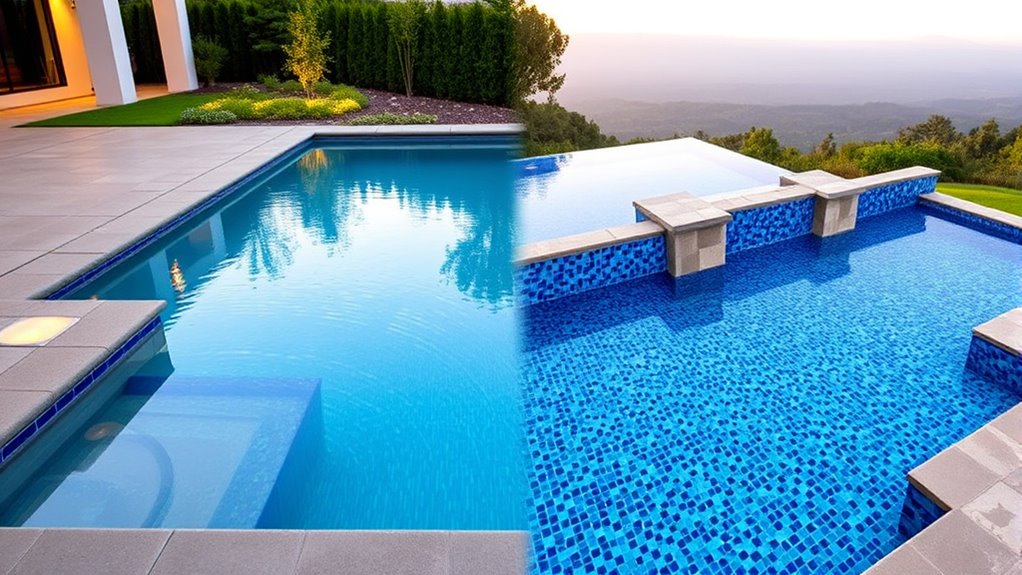
When comparing endless and traditional pools, cost and budget considerations play a crucial role in your decision. Endless pools typically have a higher upfront price due to advanced technology and compact design, but they often save you money over time through lower maintenance and energy costs. Traditional pools usually require a larger initial investment, especially if you opt for custom features or extensive landscaping. Ongoing expenses like chemicals, heating, and cleaning can add up for both options, but traditional pools tend to have higher operating costs overall. If budget is a primary concern, an endless pool might be more cost-effective long-term, even with a higher initial price. Carefully weigh the upfront costs against ongoing expenses to determine which option fits your financial plan best. Additionally, considering energy efficiency can help you make a more informed decision about long-term savings.
Space Requirements and Installation
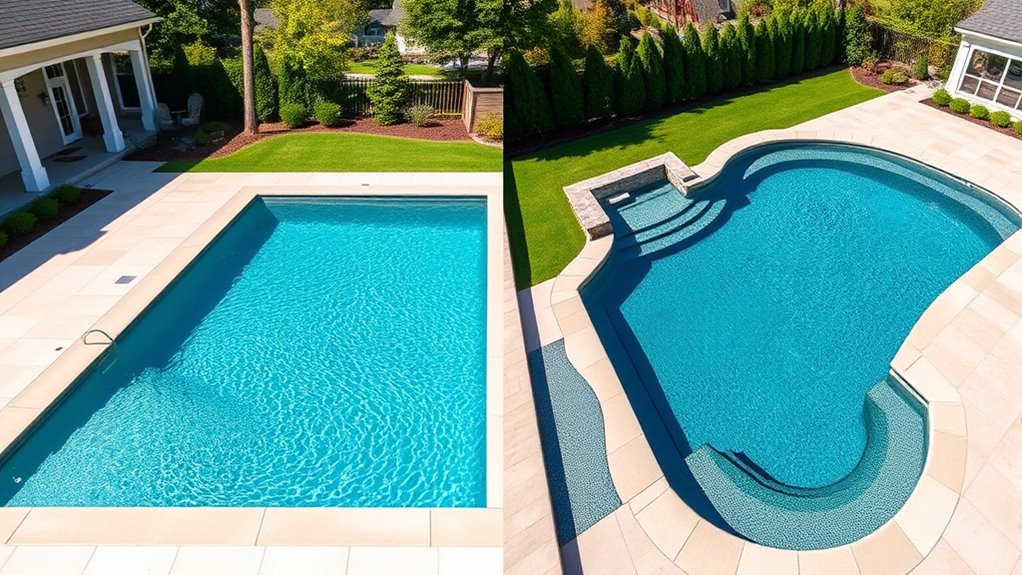
Your available space plays a key role in choosing between endless and traditional pools, as each requires different room sizes and shapes. The installation process varies, with some options needing more time and effort upfront. Understanding these aspects helps you plan effectively and select the best fit for your property and schedule. Additionally, considering space‑saving designs can help maximize your area and improve your overall setup.
Space Flexibility and Size
Endless pools typically require less space and are easier to install than traditional pools, making them a flexible option for various yard sizes. Their compact design fits in smaller or irregularly shaped spaces, offering more location options. Traditional pools often demand a larger footprint and more extensive excavation, which limits placement. To illustrate, consider the space differences:
| Pool Type | Minimum Length | Width Requirement |
|---|---|---|
| Endless Pool | 10-15 feet | 6-8 feet |
| Traditional Pool | 20-40 feet | 10-20 feet |
| Flexibility | High | Moderate |
This table shows how endless pools adapt to limited spaces, while traditional pools need more room, impacting yard layout and usability. Additionally, installation planning plays a crucial role in maximizing space efficiency for both options.
Installation Process and Time
Installing an endless pool is generally quicker and simpler than setting up a traditional pool, primarily because it requires less extensive excavation and fewer structural components. You can often set up an endless pool indoors or outdoors with minimal site preparation, sometimes within a day or two. Traditional pools, on the other hand, involve significant excavation, foundation work, and the installation of plumbing, electrical systems, and a sturdy shell, which can take several weeks. If you’re looking for a faster, more straightforward installation process, an endless pool offers a clear advantage. It also requires less space and structural reinforcement, making it easier to fit into various environments. Additionally, the installation process for an endless pool typically involves fewer permits and inspections, streamlining the overall setup. Overall, the installation time for an endless pool tends to be much shorter and less disruptive.
Maintenance and Operating Expenses
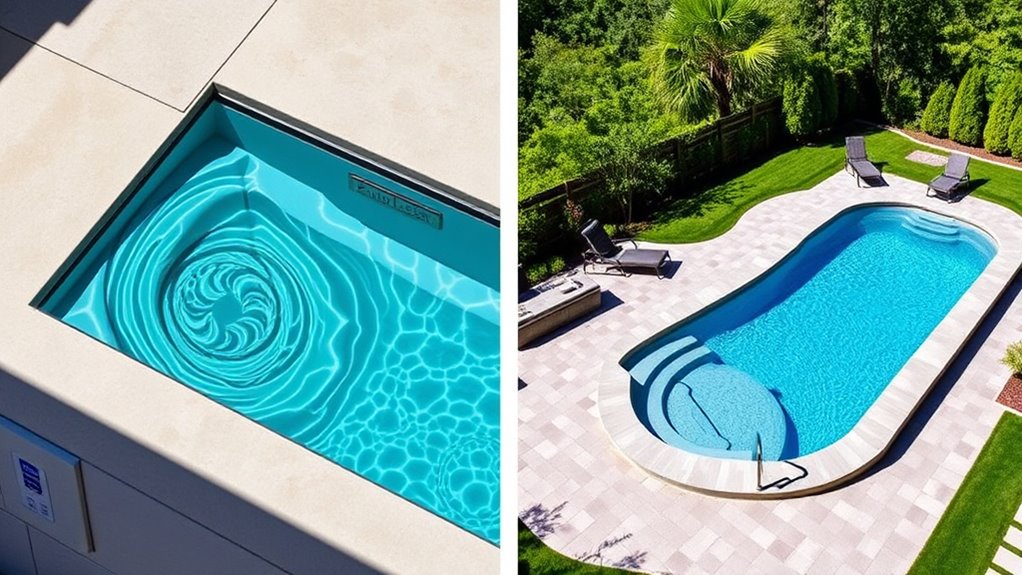
When it comes to maintenance and operating expenses, conventional pools typically require more ongoing effort and cost. You’ll need to budget for regular chemical balancing, skimming, and cleaning to keep the water clear and safe. Additionally, larger pools often have higher water and energy bills, especially if you run the pump frequently. You’ll also face costs for repairs, liner replacements, and equipment maintenance over time. In contrast, Endless Pools usually have lower operating costs because they use less water and energy, thanks to their smaller size and efficient filtration systems. Maintenance tends to be simpler, with fewer chemicals needed and less routine upkeep. Overall, traditional pools tend to be more expensive to maintain, both financially and in terms of time commitment. Also, Pimple Patch technology showcases how targeted treatments can reduce the need for extensive skincare routines, emphasizing the importance of efficient solutions.
Swimming Experience and Usage Flexibility
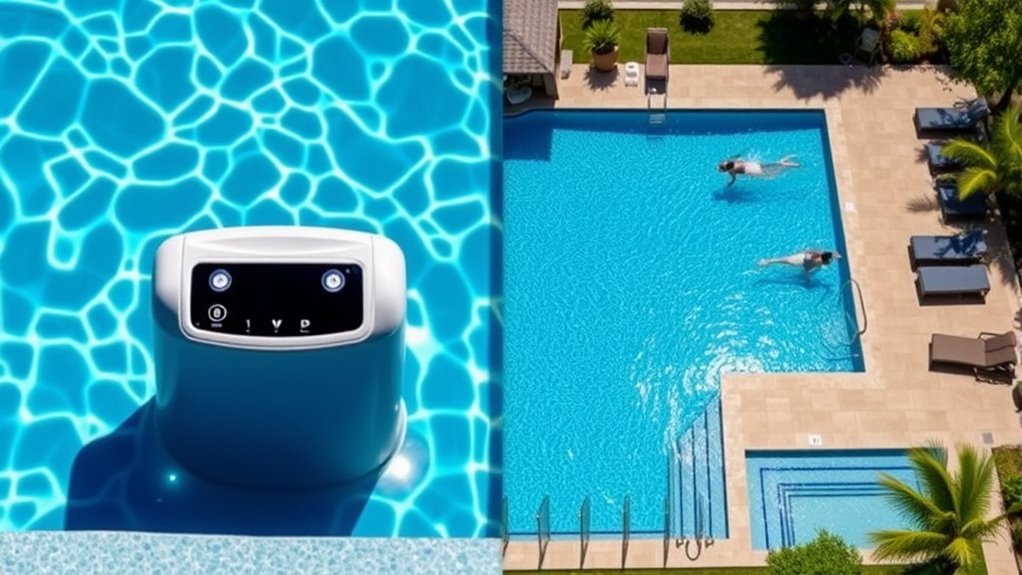
While traditional pools often require significant ongoing maintenance, they also offer a versatile swimming experience suited to a variety of preferences. You can swim laps, host social gatherings, or relax in the water, all in one space. Endless pools provide adjustable current settings, allowing you to customize your workout intensity or leisurely swim. They’re ideal for targeted training or small spaces. Additionally, their compact size makes them suitable for various living environments.
Design Options and Aesthetic Appeal
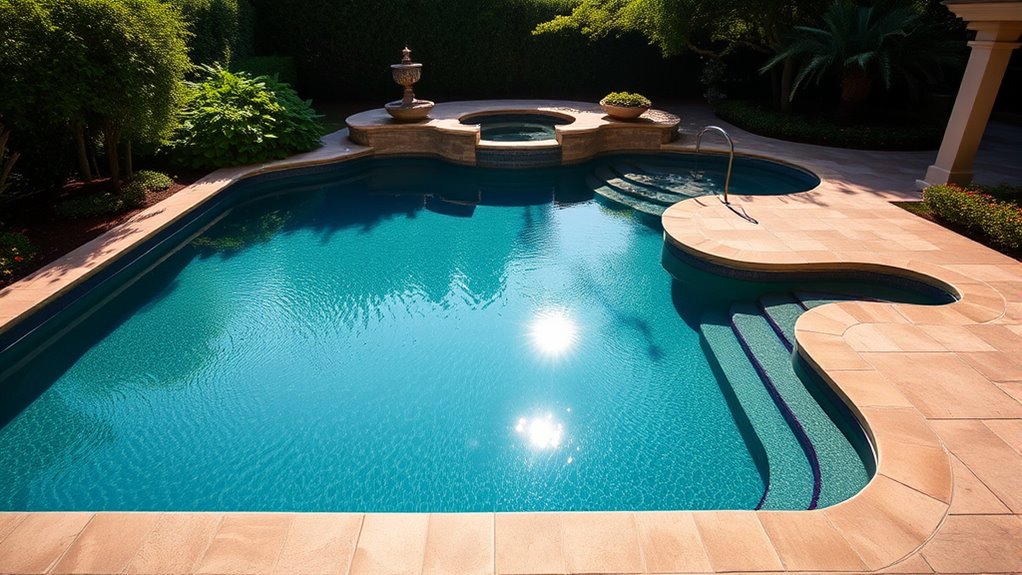
Design options and aesthetic appeal play a crucial role in choosing between traditional and endless pools, as each offers distinct visual and stylistic possibilities. Traditional pools come in various shapes, sizes, and finishes, allowing you to customize them to match your landscape and home decor. They often feature classic tiles, decking, and lighting options that create a timeless look. Endless pools, on the other hand, are sleek and compact, fitting seamlessly into smaller spaces or modern designs. Their minimalist appearance can be enhanced with customizable cabinetry, decking, and lighting, giving you a contemporary vibe. Additionally, selecting the right material, such as self watering plant pots, can complement the overall outdoor aesthetic and ensure durability. Ultimately, your choice depends on whether you prefer a traditional, spacious look or a modern, streamlined aesthetic that complements a minimalist outdoor area.
Energy Efficiency and Environmental Impact

Choosing between traditional and endless pools also involves considering their energy efficiency and environmental impact. Endless pools typically use less energy due to compact design and efficient heating systems, reducing your carbon footprint. Traditional pools, with larger volumes and older equipment, tend to consume more electricity and water for maintenance. Here’s a quick comparison:
| Feature | Endless Pool | Traditional Pool |
|---|---|---|
| Energy Consumption | Lower, energy-efficient pump and heater | Higher, larger pumps and heating costs |
| Water Use | Smaller volume, less evaporation | Larger volume, more evaporation |
| Eco-Friendly Options | Some models include solar heating | Usually rely on electric or gas |
Choosing an endless pool can mean a more eco-conscious choice, saving energy and reducing environmental impact. Additionally, the sustainable design of endless pools further enhances their environmental benefits.
Ideal Users and Lifestyle Compatibility
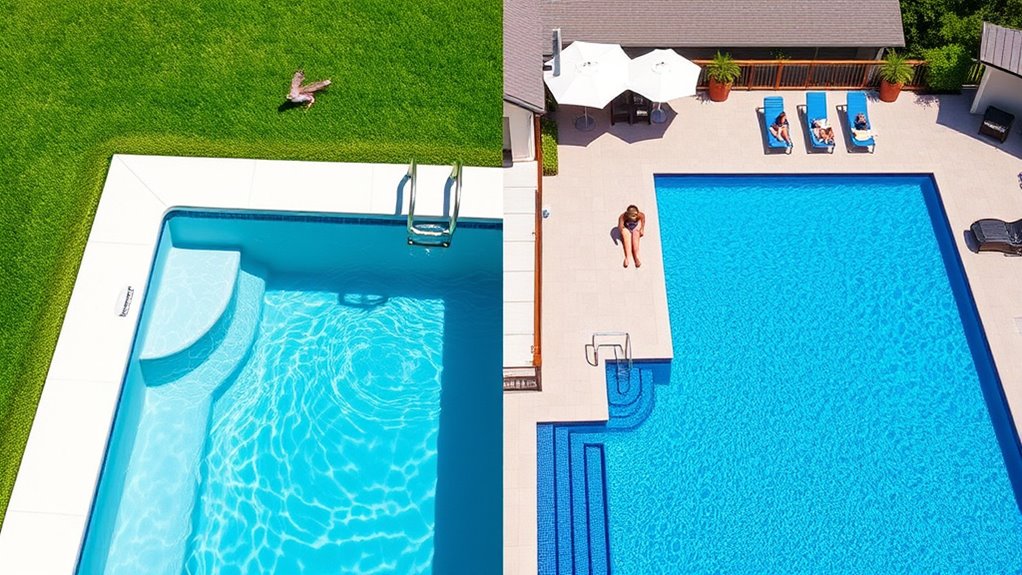
Selecting the right pool depends heavily on your lifestyle and how you plan to use it. If you enjoy daily workouts, an Endless Pool offers convenient, year-round access without needing much space. Its compact design fits well into smaller homes or garages, making it ideal for fitness enthusiasts with busy schedules. On the other hand, if you love hosting gatherings or want a versatile space for relaxation and recreation, a traditional pool might suit you better. Traditional pools provide more room for swimming laps, lounging, and socializing. Consider your activity preferences, available space, and how often you’ll use the pool. Your lifestyle will determine whether a compact, functional Endless Pool or a spacious, versatile traditional pool fits seamlessly into your daily routine.
Frequently Asked Questions
How Long Does It Take to Install an Endless Pool Compared to a Traditional Pool?
It typically takes about 1 to 2 weeks to install an Endless Pool, depending on your setup and customization. In contrast, traditional pools can take 4 to 12 weeks, given their larger size and more complex construction. You’ll find that Endless Pools are quicker and easier to install, making them a convenient option if you want faster access to swimming. Planning ahead helps make certain of a smooth and timely setup process.
Can an Endless Pool Be Integrated Into an Existing Outdoor Space?
Think of your outdoor space as a blank canvas ready for a splash of innovation. Yes, you can integrate an endless pool into your existing outdoor area. It’s designed with flexibility, often fitting into smaller or irregular spaces. You’ll likely need some customization, such as adjusting the surrounding deck or landscaping, but with careful planning, your outdoor oasis can seamlessly include this sleek, space-saving feature, transforming your backyard into a private retreat.
Are There Health Benefits Unique to Endless Pools Over Traditional Pools?
Yes, endless pools offer unique health benefits like low-impact exercise and adjustable resistance, making them ideal for targeted workouts and physical therapy. You can easily customize your swim experience, which helps improve cardiovascular health, strength, and flexibility. Unlike traditional pools, their compact size allows you to use them year-round, even in smaller spaces. This personalized, versatile setup encourages consistent use, boosting your overall health and fitness levels.
What Safety Features Are Available for Both Pool Types?
Safety features in pools are like a sturdy shield protecting you. Both endless and traditional pools offer features like non-slip surfaces, safety covers, alarms, and fencing options. Endless pools often include automatic shut-off systems and child safety locks, while traditional pools may have pool alarms and removable barriers. You can customize safety measures to fit your needs, ensuring peace of mind whether you prefer the compact convenience of an endless pool or a larger traditional one.
How Does the Resale Value of a Home Change With an Endless Pool?
Adding an endless pool can boost your home’s resale value by showcasing modern amenities and fitness options that appeal to buyers. Its compact design saves space, making it attractive for smaller yards or indoor setups. However, the impact varies based on your local market and home type. You’ll want to highlight its benefits during showings to maximize appeal, but be prepared for some buyers to prefer traditional pools.
Conclusion
Choosing between an endless pool and a traditional pool is like picking the right key for your musical tune. Consider your space, budget, and lifestyle to find your perfect match. An endless pool offers convenience and flexibility, while a traditional pool provides grandeur and social appeal. Whichever you choose, make sure it fits seamlessly into your life’s rhythm. After all, your backyard should be a sanctuary where every splash echoes your personal style and passions.









